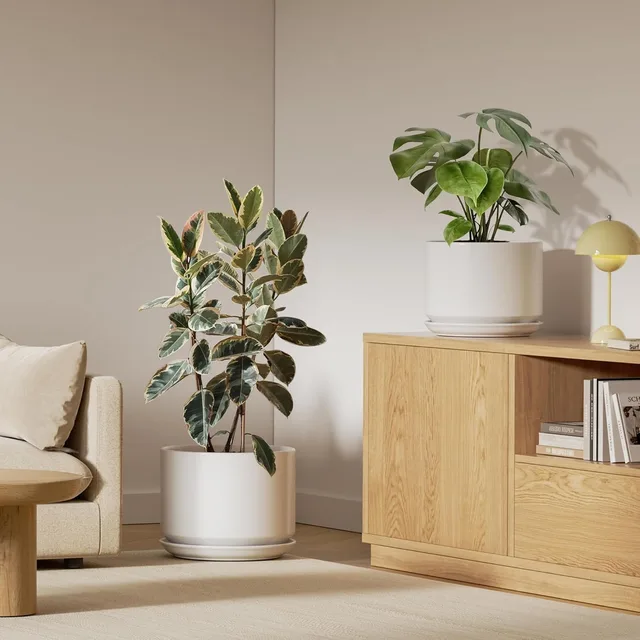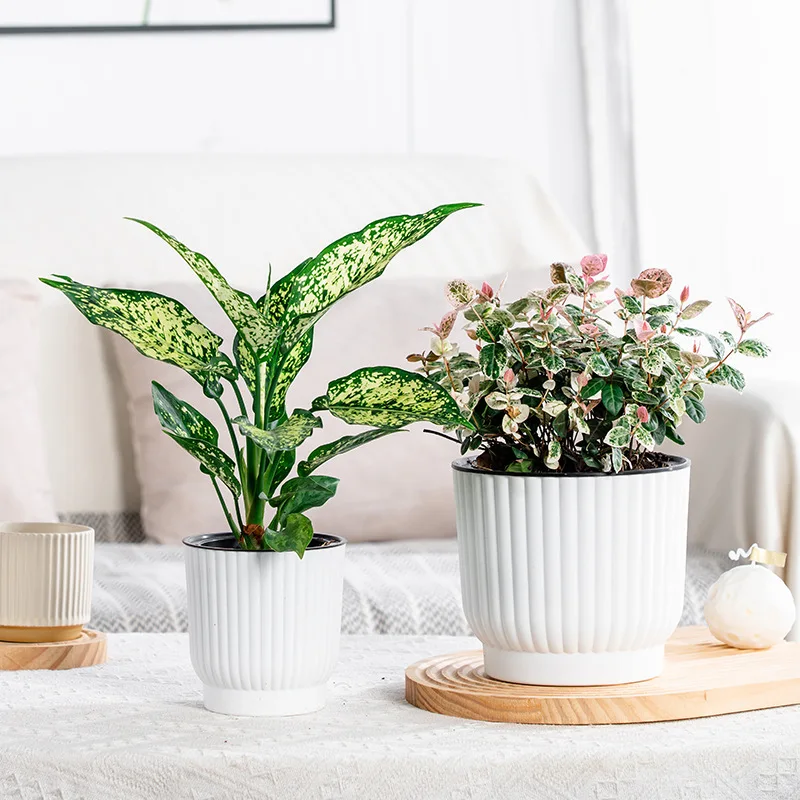Importance of Correct Pot Sizing
Pot size greatly affects plant well-being. Right pot sizes support healthy root systems and proper moisture levels. This enables plants to absorb nutrients and water effectively, aiding their growth. Conversely, improper pot sizes can result in poor plant health. Small pots may constrict roots, limiting growth. Oversized pots can retain excess water, risking root rot. Proper pot sizing thus ensures plant health and vibrant growth.
Impact on Plant Health and Growth
Choosing the correct pot size is vital for plant health. A pot too small can restrict root growth, stunt overall development, and even lead to root-bound conditions. Overly large pots hold too much soil, which remains damp longer. This environment can encourage diseases like root rot. Hence, a pot that fits your plant’s size ensures adequate room for growth and soil aeration.
Aesthetic Considerations for Garden Design
Beyond health, pot size influences garden aesthetics. A plant in a pot that complements its size creates visual harmony. Pots too large or small can disrupt the balance of your garden design. Choosing the right-sized pots can enhance the beauty of plants, making your space more inviting. Thus, correct pot sizing also carries significant aesthetic value for your garden.

Basic Techniques for Measuring Pots
Properly measuring your plant pots is crucial for selecting the right size. This ensures healthy plant growth and complements your garden design. The process varies depending on the shape of the planter.
Measuring Pot Diameter for Round Planters
To measure the diameter of a round planter, use a tape measure. Stretch it across the planter’s top from one side to the other. Always measure the widest part of the planter, typically along the top rim. Record this measurement as your planter’s diameter. It helps in understanding if the pot fits the root spread of your plant.
Determining Pot Size for Square and Rectangular Planters
For square and rectangular planters, measure the length and width at the top opening. Place your measuring tape on the inside edge of the planter’s opening, not the outside, to get accurate dimensions. These measurements are essential to ensure that the soil space is adequate for the plant’s roots to expand.
Calculating Pot Volume
Calculating the volume of a pot helps you determine how much soil it can hold. For round pots, use the equation (\pi r^2 h) where (r) is half the diameter, and (h) is the height. For square or rectangular pots, multiply length by width by height ((l \times w \times h)). This tells you if the pot can hold enough soil to support the plant’s nutritional needs.
Choosing the Right Pot for Your Plant
Selecting the correct pot is crucial for your plant’s health and growth. The pot size should match the current and future size of your plant to ensure it has enough room to grow. Picking a pot that’s neither too large nor too small can save a lot of hassle and gives your plant best conditions to thrive.
Understanding Plant Size and Pot Proportionality
When choosing a pot, consider the size of your plant. As a general rule, aim for a pot that is about 2″ larger than the size of your current nursery container. This allows extra room for the roots to grow. The pot’s depth is also important, especially for plants with deep root systems. It’s vital to provide enough space for the roots to expand without being restricted.
The Relationship Between Pot Size and Plant Growth
The size of the pot can significantly impact your plant’s health and growth potential. A pot that is too small can restrict root growth, which in turn stunts the plant’s overall development. Conversely, a pot that’s too large for the plant can lead to over-watering issues, causing root rot. The right-sized pot promotes adequate root expansion and proper moisture retention in the soil, which are crucial for healthy plant growth.
Pot Features and Plant Health
Choosing the right pot goes beyond just measuring for size; pot features play a vital role in plant health. Prioritizing drainage and material can make a big difference.
The Role of Drainage in Pot Selection
Drainage is key for preventing water from sitting in the pot, which can harm plant roots. Always pick pots with drainage holes at the bottom. This will allow excess water to escape and prevent issues like root rot. If the pot lacks holes, consider drilling some or use a layer of gravel at the base for water management.
Material and Construction Considerations
Material affects a pot’s durability and plant health. Clay and ceramic pots are porous, allowing air and moisture to move through. This helps prevent soil diseases and supports root health. Plastic and resin pots are lightweight and come in many shapes and sizes, but they can hold more moisture. Always assess material qualities and pick the one that’s best for your plant’s needs.

Common Pitfalls in Pot Measurement
When measuring pots for plants, mistakes can lead to poor growth and health.
What Happens When Pots Are Too Small?
A pot too snug traps roots, making plants weak.
Small pots limit root spread and stunt plant growth.
Plants can become root-bound, leading to stress and disease.
A tight space may prevent necessary water and nutrient uptake.
The Consequences of Oversized Pots
Too large pots can hold extra water, causing roots to rot.
Big pots may make soil stay wet too long, inviting mold.
Roots in large pots may grow poorly due to water imbalance.
Plants in oversized pots often use more energy on root growth.
Expert Tips for Pot and Plant Compatibility
Choosing the right pot for your plants is not just about measuring. It’s about understanding each plant’s needs and growth patterns. Here are expert tips to help ensure your plants live in compatible pots.
Matching Plants With Their Ideal Pot Size
- Know your plant’s roots: Some plants have deep roots, so they need deep pots. Others have shallow roots and do better in wider, shallower pots.
- Consider growth rate: Quick-growing plants need more space. Choose a pot that can handle the growth over time.
- Look at the foliage: Large leaves or vines need pots that balance the top-heavy growth. This prevents tipping.
- Check plant tags for hints: Plant tags often advise on pot size. This can guide you to the ideal pot.
Adjusting Pot Sizes for Growing Plants
- Plan for repotting: Plants grow, and their pot needs change. Be ready to move them to a larger pot as they grow.
- Watch for signs: If you see roots at the soil surface or through the drainage holes, it’s time for a bigger pot.
- Change gradually: When moving to a larger pot, go up in size slowly. Too much space can harm plant growth.
Using these tips, you can create a better space for your plants to thrive. And with the correct pot, your plants will have healthier growth, leading to a more beautiful and balanced garden.

Additional Resources for Gardeners
Gardening requires reliable resources for success. Whether you are new or experienced, access to the right information can make significant differences.
Where to Find Help and Advice
For additional help and advice on gardening and pot measurements, many platforms are available. Gardening blogs, online forums, and community groups often share insights and personal experiences that can be invaluable. Local garden centers and nurseries also offer personalized advice and workshops.
Online Tools and Calculators for Pot Measurements
Several online tools help with precise pot measurements. Websites like ‘PotSizeCalculator.com’ or ‘Gardeners.com’ provide specific calculators. These tools take inputs like plant type and size to suggest optimal pot dimensions. They make it easier to avoid common potting mistakes.
